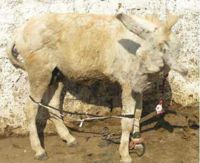Rabies - Donkey
Introduction
Rabies, caused by a lyssavirus, is a fatal neurological disease that can occur in all mammals. It has been recorded in most parts of the world. The usual method of transmission is from infected urban dogs and/or from sylvatic hosts. Sylvatic hosts vary between geographical locations. For example, in parts of Europe foxes are predominantly responsible for transmission, whereas in South America vampire bats are the main vectors.
Since 1902, all cases of rabies seen in the UK have been acquired overseas in countries where the disease is endemic. The last case of terrestrial animal rabies was in 1922. However, in 1996 bats in the UK were recognised as carriers of a rabies-like virus, European Bat Lyssavirus 2, which can also be lethal to humans (Lamont, 2003). In 2002, the first recorded case in 100 years of indigenous human rabies by a bat bite was recorded in the UK. According to the WHO definition, in the absence of terrestrial rabies the UK is still officially rabies-free, whereas significant numbers of rabies cases continue to be reported in Eastern Europe.
The World Health Organisation produces a quarterly report of cases. In the second quarter of 2003, 14 cases of equine rabies were recorded which represented 0.5% of the total rabies cases reported. Some reports list donkeys separately. For example, in the fourth quarter of 2001, two cases from a total of 189 dog-mediated cases reported in Turkey involved donkeys (WHO, 2001).
Donkeys are at risk of attack by rabid dogs or hyenas as they are often kept outside at night or allowed to wander freely. It has been stated that donkeys are over-represented in livestock being attacked by rabid animals and this has been attributed to their spontaneous aggression towards inquisitive canines. In Latin America, vampire bats attack donkeys more often than horses, possibly due to the more docile nature of the donkey (Aubert, 1996).
Clinical signs

Classically these are divided into the furious (encephalitic) form and the dumb (paralytic) form. The disease typically involves a combination of the two forms. Survival from an experimental inoculation of the rabies virus has been demonstrated in the donkey (Ferris, 1968) but field infections are invariably fatal.
The clinical signs of rabies in the horse include change of behaviour, colic, self-mutilation, agitation, baring teeth, foaming at the mouth, paresis or spastic or flaccid paralysis in one or more limbs, and convulsions (Aubert, 1996). There have also been anecdotal reports in the donkey. Five cases seen in Debre Zeit, Ethiopia (B. Endebu, personal communication) presented with self-mutilation and aggressive behaviour. Any rapidly progressing neurological condition should be considered suspicious of rabies, especially if accompanied by obvious bite wounds or a history of exposure to rabid animals.
Diagnosis (post-mortem)
The complete head of the donkey may be submitted for laboratory diagnosis, where the brain stem and cord will be examined for pathognomonic changes.
Treatment
- Euthanasia
- Strict health and safety rules should be observed for all personnel handling potentially infected animals (Department of Health, 2000)
Control
- Vaccination of the donkey
- Vaccination and programmes to control numbers of urban and feral dogs
- Control and vaccination of sylvatic hosts in some cases
- Housing of donkeys at night to prevent attacks by rabid animals
Literature Search
Use these links to find recent scientific publications via CAB Abstracts (log in required unless accessing from a subscribing organisation).
Rabies in donkeys publications
References
- Anzuino, J. (2008) Exotic infections In Svendsen, E.D., Duncan, J. and Hadrill, D. (2008) The Professional Handbook of the Donkey, 4th edition, Whittet Books, Chapter 14
- Aubert, M. (1996). ‘Rabies’. Virus infections of equines. M. J. Studdert (ed). Elsevier, Amsterdam. pp 247-264.
- Department of Health (2000). ‘Memorandum on Rabies: Prevention and control’. www.doh.gov.uk/memorandumonrabies.
- Ferris, D. H., Badiali, L., Abou-Youssef, M., and Beamer, P.D. (1968). ‘A note on experimental rabies in the donkey’. Cornell Vet 58. pp 270-277.
- Lamont, M. (2003). ‘European bat Lyssavirus in Great Britain’. State Veterinary Journal. Winter edition 2003 13(2). pp 2-5. www.defra.gov.uk/animalh/svj/vol1302/svj-vol1302.pdf. (currently not available but a 2008 bulletin is available at http://www.defra.gov.uk/news/2008/080509.htm)
- WHO (2001). Rabies Bulletin Europe. Fourth quarter. http://www.whorabies-bulletin.org (currently not available)
|
|
This section was sponsored and content provided by THE DONKEY SANCTUARY |
|---|
